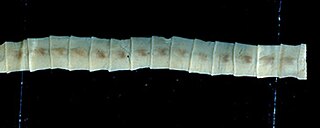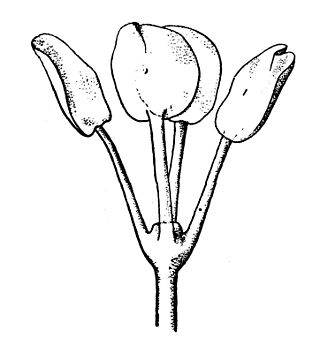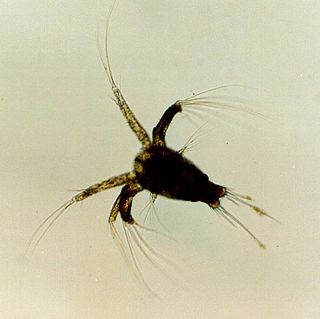Related Research Articles

In biology, a biological life cycle is a series of stages of the life of an organism, that begins as a zygote, often in an egg, and concludes as an adult that reproduces, producing an offspring in the form of a new zygote which then itself goes through the same series of stages, the process repeating in a cyclic fashion.

Diphyllobothrium is a genus of tapeworms which can cause diphyllobothriasis in humans through consumption of raw or undercooked fish. The principal species causing diphyllobothriasis is D. latum, known as the broad or fish tapeworm, or broad fish tapeworm. D. latum is a pseudophyllid cestode that infects fish and mammals. D. latum is native to Scandinavia, western Russia, and the Baltics, though it is now also present in North America, especially the Pacific Northwest. In Far East Russia, D. klebanovskii, having Pacific salmon as its second intermediate host, was identified.

Haemonchus contortus, also known as the barber's pole worm, is a very common parasite and one of the most pathogenic nematodes of ruminants. Adult worms attach to abomasal mucosa and feed on the blood. This parasite is responsible for anemia, oedema, and death of infected sheep and goats, mainly during summer in warm, humid climates.

Echinococcus granulosus, also called the hydatid worm, hyper tape-worm or dog tapeworm, is a cyclophyllid cestode that dwells in the small intestine of canids as an adult, but which has important intermediate hosts such as livestock and humans, where it causes cystic echinococcosis, also known as hydatid disease. The adult tapeworm ranges in length from 3 mm to 6 mm and has three proglottids ("segments") when intact—an immature proglottid, mature proglottid and a gravid proglottid. The average number of eggs per gravid proglottid is 823. Like all cyclophyllideans, E. granulosus has four suckers on its scolex ("head"), and E. granulosus also has a rostellum with hooks. Several strains of E. granulosus have been identified, and all but two are noted to be infective in humans.

Echinococcus multilocularis, the fox tapeworm, is a small cyclophyllid tapeworm found extensively in the northern hemisphere. E. multilocularis, along with other members of the Echinococcus genus, produce diseases known as echinococcosis. Unlike E. granulosus,E. multilocularis produces many small cysts that spread throughout the internal organs of the infected animal. The resultant disease is called Alveolar echinococcosis, and is caused by ingesting the eggs of E. multilocularis.

Cutaneous larva migrans is a skin disease in humans, caused by the larvae of various nematode parasites of the hookworm family (Ancylostomatidae). The parasites live in the intestines of dogs, cats, and wild animals; they should not be confused with other members of the hookworm family for which humans are definitive hosts, namely Ancylostoma duodenale and Necator americanus.

Tetraphyllidea is a large tapeworm order that contains some 60 genera and about 800 described species. Tetraphyllideans are remarkable for their scolex morphologies, which are the most varied and morphologically complex amongst all tapeworm orders.

Parasitic worms, also known as helminths, are large macroparasites; adults can generally be seen with the naked eye. Many are intestinal worms that are soil-transmitted and infect the gastrointestinal tract. Other parasitic worms such as schistosomes reside in blood vessels.
Spirometra erinaceieuropaei is a parasitic tapeworm that infects domestic animals and humans. The medical term for this infection in humans and other animals is sparganosis. Morphologically, these worms are similar to other worms in the genus Spirometra. They have a long body consisting of three sections: the scolex, the neck, and the strobilia. They have a complex life cycle that consists of three hosts, and can live in varying environments and bodily tissues. Humans can contract this parasite in three main ways. Historically, humans are considered a paratenic host; however, the first case of an adult S. erinaceieuropaei infection in humans was reported in 2017. Spirometra tapeworms exist worldwide and infection is common in animals, but S. erinaceieuropaei infections are rare in humans. Treatment for infection typically includes surgical removal and anti-worm medication.

The glochidium is a microscopic larval stage of some freshwater mussels, aquatic bivalve mollusks in the families Unionidae and Margaritiferidae, the river mussels and European freshwater pearl mussels.

Glyptapanteles is a genus of endoparasitoid wasps found in all continents, except Antarctica. The larvae of Glyptapanteles species are able to manipulate their hosts into serving as bodyguards.

The microfilaria is an early stage in the life cycle of certain parasitic nematodes in the family Onchocercidae. In these species, the adults live in a tissue or the circulatory system of vertebrates. They release microfilariae into the bloodstream of the vertebrate host. The microfilariae are taken up by blood-feeding arthropod vectors. In the intermediate host the microfilariae develop into infective larvae that can be transmitted to a new vertebrate host.

Cestoda is a class of parasitic worms in the flatworm phylum (Platyhelminthes). Most of the species—and the best-known—are those in the subclass Eucestoda; they are ribbon-like worms as adults, known as tapeworms. Their bodies consist of many similar units known as proglottids—essentially packages of eggs which are regularly shed into the environment to infect other organisms. Species of the other subclass, Cestodaria, are mainly fish infecting parasites.
Diphyllobothrium mansonoides is a species of tapeworm (cestodes) that is endemic to North America. Infection with D. mansonoides in humans can result in sparganosis. Justus F. Mueller first reported this organism in 1935. D. mansonoides is similar to D. latum and Spirometra erinacei. When the organism was discovered, scientist did not know if D. mansonoides and S. erinacei were separate species. PCR analysis of the two worms has shown the two to be separate but closely related organisms.
Gnathostoma hispidum is a nematode (roundworm) that infects many vertebrate animals including humans. Infection of Gnathostoma hispidum, like many species of Gnathostoma causes the disease gnathostomiasis due to the migration of immature worms in the tissues.

Crustaceans may pass through a number of larval and immature stages between hatching from their eggs and reaching their adult form. Each of the stages is separated by a moult, in which the hard exoskeleton is shed to allow the animal to grow. The larvae of crustaceans often bear little resemblance to the adult, and there are still cases where it is not known what larvae will grow into what adults. This is especially true of crustaceans which live as benthic adults, more-so than where the larvae are planktonic, and thereby easily caught.

Scallop aquaculture is the commercial activity of cultivating (farming) scallops until they reach a marketable size and can be sold as a consumer product. Wild juvenile scallops, or spat, were collected for growing in Japan as early as 1934. The first attempts to fully cultivate scallops in farm environments were not recorded until the 1950s and 1960s. Traditionally, fishing for wild scallops has been the preferred practice, since farming can be expensive. However worldwide declines in wild scallop populations have resulted in the growth of aquaculture. Globally the scallop aquaculture industry is now well established, with a reported annual production totalling over 1,200,000 metric tonnes from about 12 species. China and Japan account for about 90% of the reported production.
Protelean organisms are widely regarded as a special class of parasites, often referred to as parasitoids. Protelean parasites refer to insects that begin the juvenile phase of their lives as parasites and ultimately destroy or consume their host to emerge as free-living adults. Defining attributes of Protelean parasitoids include a parasitic nature that is confined to the larval stage, destruction of a single host, and an independent mature stage. Other distinguishing characteristics include a body size similar to its host and a comparatively simple life style. Parasitoids and their hosts are typically in the same taxonomic class.

Parascaris equorum is a species of ascarid that is the equine roundworm. Amongst horse owners, the parasites are colloquially called "Ascarids". This is a host-specific helminth intestinal parasite that can infect horses, donkeys, and zebras. Horses up to six months of age are the most susceptible to infection. After this time, infection rates begin to decline and is extremely uncommon in horses over twelve months of age. It cannot infect humans or other animals. It is yellow-white in color, and females can become as large as 15 inches (38 cm) in length. Found worldwide, P. equorum is one of the most difficult equine parasites to kill, requiring larger doses of more powerful anthelmintic medications than are needed for other equine parasites.

Diphyllobothrium dendriticum is a large pseudophyllid cestode of the family Diphyllobothriidae.
References
- 1 2 Durrani MI, Basit H, Blazar E (27 June 2022). "Diphyllobothrium Latum". StatPearls. Treasure Island, Florida: StatPearls Publishing. PMID 31082015 . Retrieved 29 November 2023– via National Library of Medicine.
- ↑ "Definition of PROCERCOID". www.merriam-webster.com. Retrieved 2018-01-14.
- 1 2 Chappell, L. H. (1979). Physiology of Parasites. London: Blackie. pp. 131, 134, 139. ISBN 978-1-4684-7808-2.